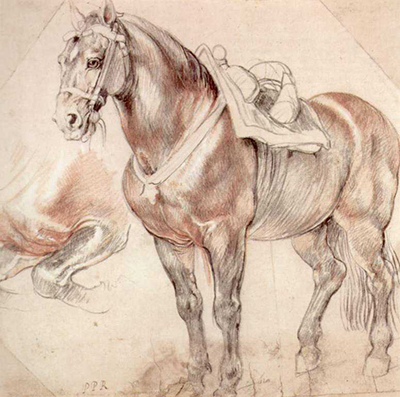Rubens would use horses in many of his large oil paintings but considerable practice was required in order to master this animal's complex anatomy
This beautiful animal would often hold a symbolic significance to artistic themes, boasting beauty in some scenarios and strength in others.
When depicting military figures, Rubens would often place them on horses in order to lift them up, promoting the feeling of strength and power. There were also active paintings where horses were seen in battle, with their limbs stretched into all manner of contortions.
Etude of Horse found here is sometimes referred to as a Horse Study and captures some of the raw details that the artist would need to concentrate on when adding this animal into his compositions. You will see that alongside the main portrait is an unfinished sketch of the front part of the horse.
George Stubbs, an English artist from several decades later, was the most skilled at capturing horses in art. He concentrated on this theme more than anyone else and would even disect horse corpses in order to ensure the most accurate reproductions possible.
This versatile animal can be used in all manner of different artistic styles, see the simplicity of line used by Pablo Picasso in this Horse sketch. He carried this single line concept onto many other animals such as dogs, cats, penguins and flamingoes.
Rubens used several different colours in this drawing in order to first lay the base of detail before focusing on several specific areas where he wanted to lure the viewer's eye. The evidence available here suggests that the purpose of this study piece was to practice the front end of a horse for a future work, as he covers it twice here and also uses amongst the most detail of anywhere in the composition.




